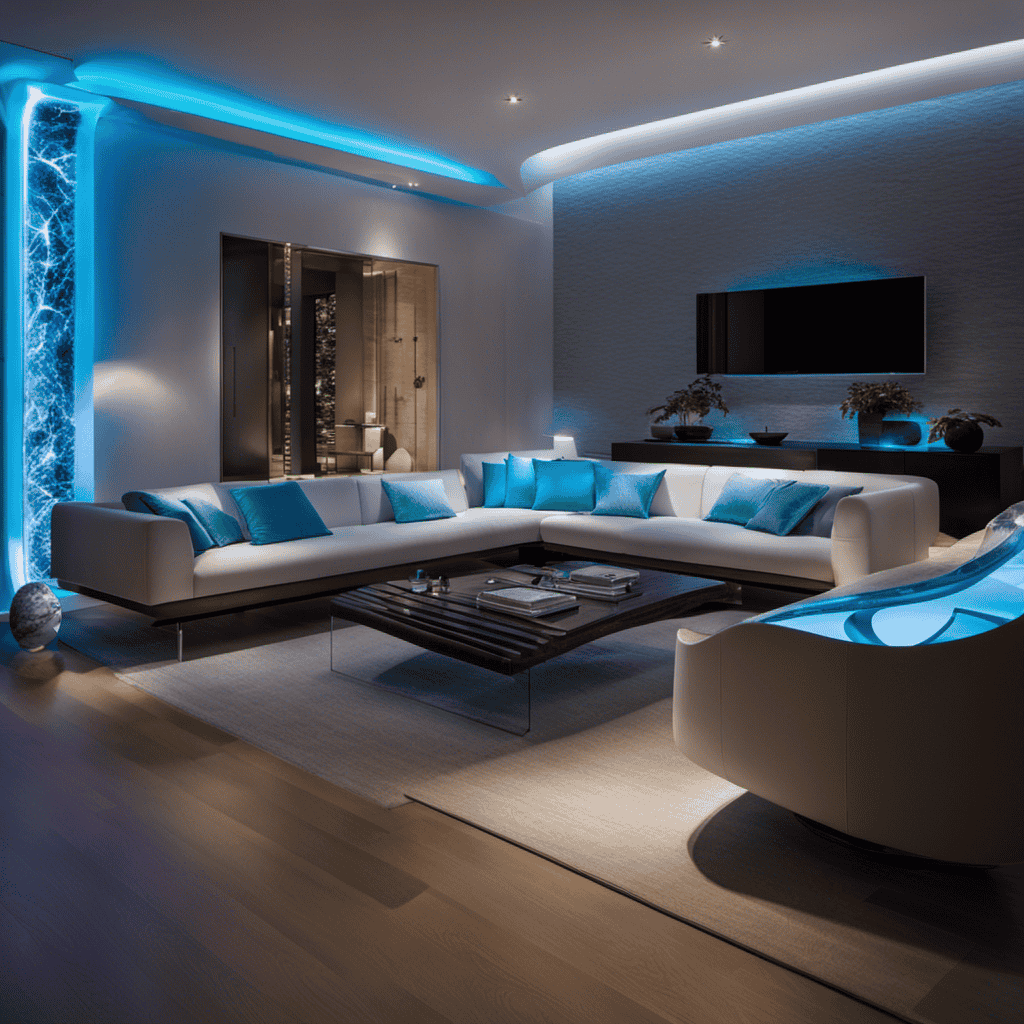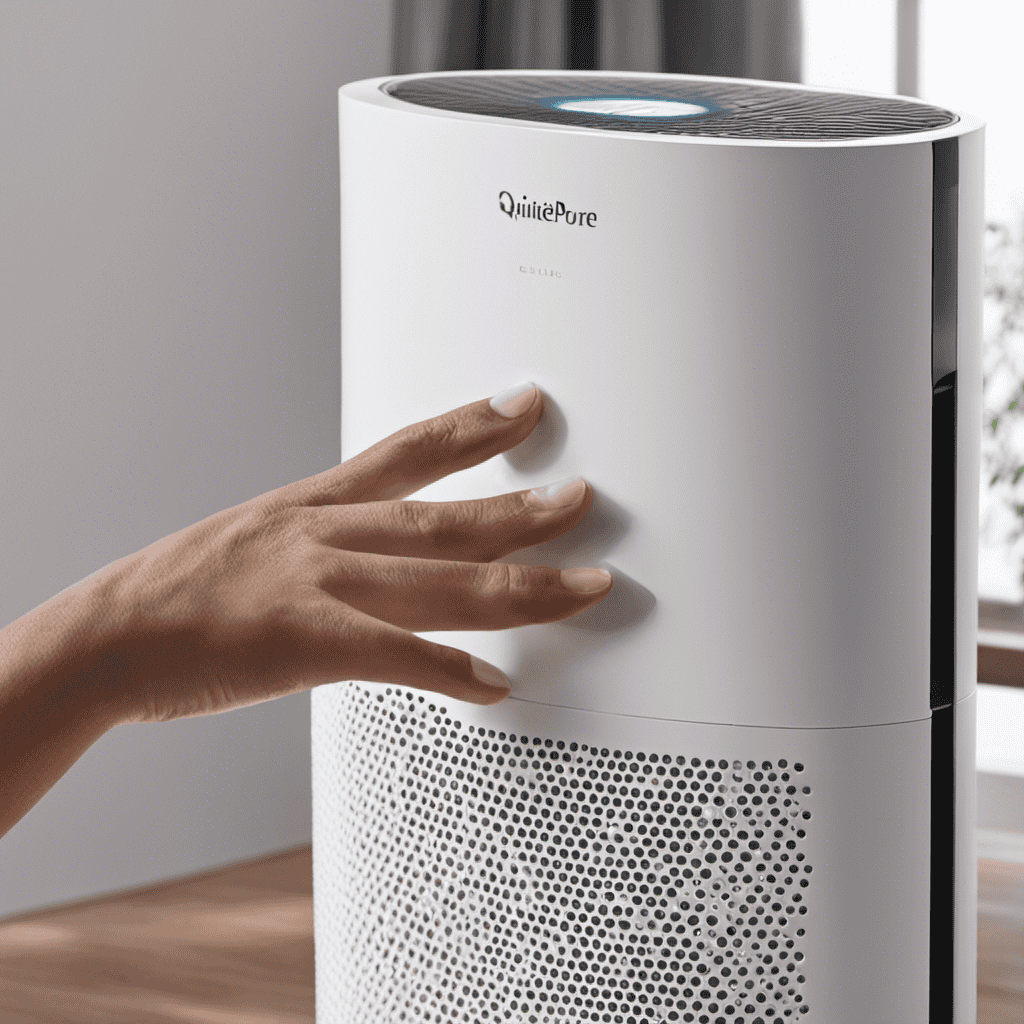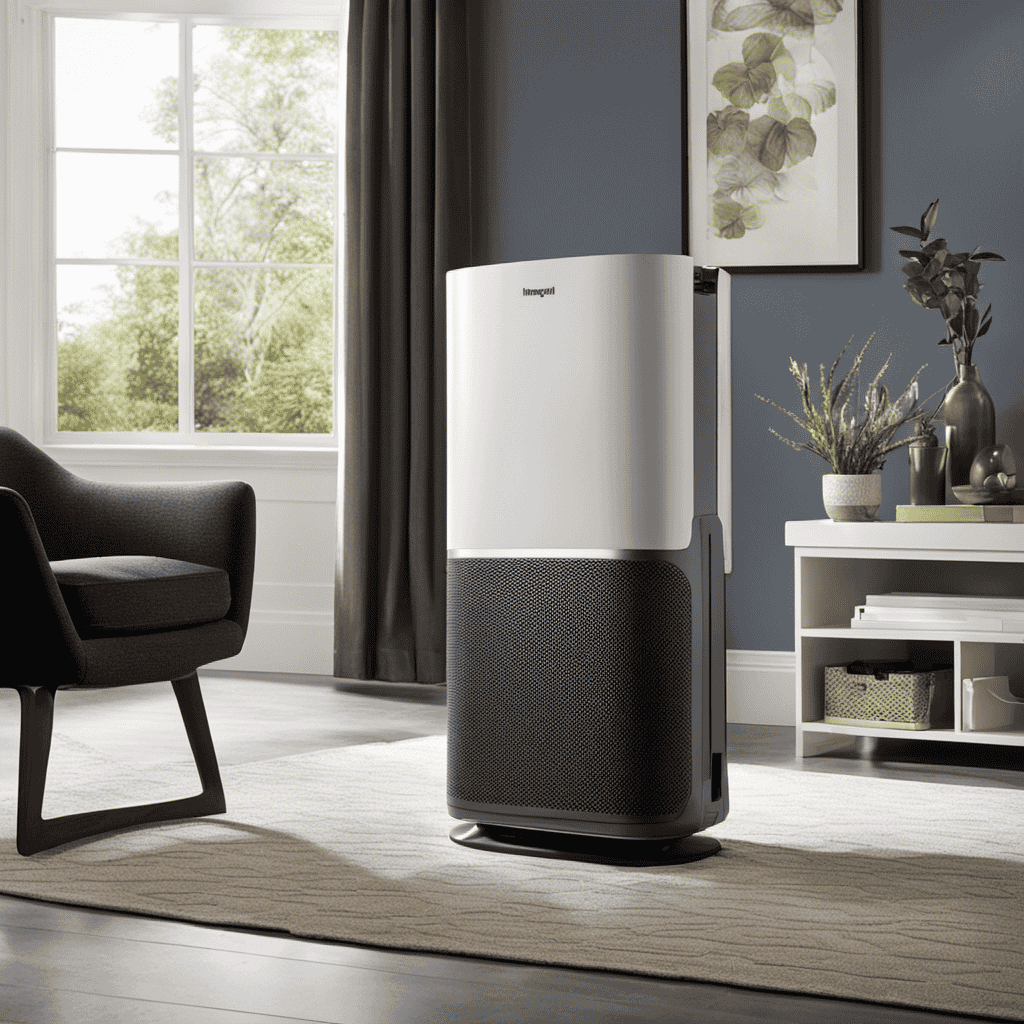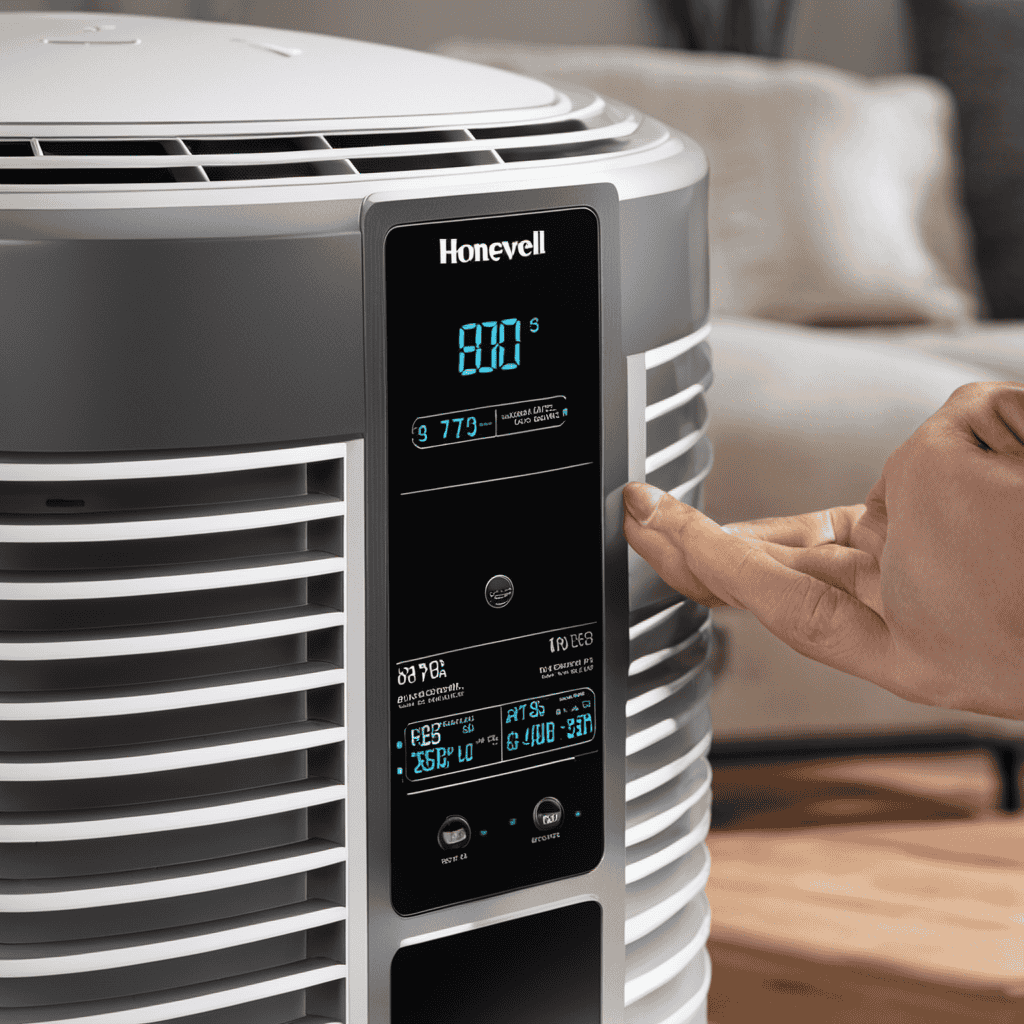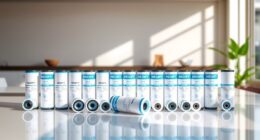When it comes to maintaining clean and pollutant-free air in my home, I trust in the effectiveness of plasma air purifiers. These state-of-the-art devices utilize advanced technology to eliminate airborne pollutants and enhance the overall quality of air.
In this article, I will delve into the science behind plasma air purification, explaining how these devices work and the benefits they offer. Get ready to discover the fascinating world of plasma air purifiers and how they can revolutionize the air you breathe.
Key Takeaways
- Plasma air purifiers use advanced technology to remove airborne contaminants and improve air quality.
- Plasma filters use a high-voltage electric field to create reactive oxygen species that neutralize pollutants.
- Plasma filtration targets smaller particles and neutralizes harmful pollutants compared to traditional filters.
- Plasma air purifiers effectively remove airborne contaminants, including bacteria and viruses, and eliminate odors and harmful gases.
The Science Behind Plasma Air Purifiers
Plasma air purifiers use electrical charges to neutralize airborne particles and improve indoor air quality. This innovative technology, known as plasma air purification, works by creating a plasma field that generates a combination of positive and negative ions. These ions attach themselves to the harmful particles present in the air, such as dust, pollen, and bacteria.
The charged particles then become heavy and fall to the ground or get trapped in the purifier’s filter, effectively removing them from the air. Plasma air purifiers are highly effective in eliminating contaminants, including volatile organic compounds (VOCs) and odors. This technology has been proven to be more efficient than traditional air purifiers, as it not only filters the air but actively destroys harmful substances.
Understanding Plasma Technology in Air Purification
When it comes to air purification, there are two main types of filters: plasma filters and traditional filters.
Plasma filters use a high-voltage electric field to create reactive oxygen species that neutralize airborne pollutants.
Traditional filters, on the other hand, physically trap particles in a mesh.
The benefit of plasma purification is that it not only removes particles from the air, but also eliminates harmful gases and odors, providing a more comprehensive purification solution.
Plasma Vs. Traditional Filters
Traditional filters are effective at removing larger particles from the air, whereas plasma technology can target smaller particles and neutralize harmful pollutants.
Plasma filtration is a cutting-edge air purification method that utilizes high-energy plasma to eliminate airborne contaminants.
Unlike traditional filters, which rely on physical barriers to trap particles, plasma purifiers generate an electric field that ionizes the air. This process creates positive and negative ions that attach to the particles, causing them to clump together and become heavy enough to be captured by the purifier’s collection plates or filters.
By effectively removing even the tiniest particles, plasma filtration significantly improves air quality and reduces the presence of allergens, bacteria, viruses, and other harmful substances.
This advanced technology offers numerous benefits over traditional filters, making plasma purification a superior choice for those seeking cleaner and healthier indoor air.
Benefits of Plasma Purification
With plasma purification, you’ll experience fresher and cleaner indoor air, free from allergens and harmful pollutants. Plasma air purifiers offer several advantages over traditional filters.
One of the main positive effects is their ability to effectively remove airborne contaminants. Unlike regular filters that simply trap particles, plasma purifiers use ionization technology to neutralize and eliminate pollutants. When air passes through the plasma field, the charged ions attach to the airborne particles, causing them to become heavy and fall to the ground or get trapped by the purifier’s collection plates. This process ensures that even the tiniest particles, such as bacteria and viruses, are eradicated.
Additionally, plasma purification can eliminate odors and harmful gases, making your indoor environment healthier and more pleasant.
Now, let’s explore how plasma air purifiers remove airborne contaminants in more detail.
How Plasma Air Purifiers Remove Airborne Contaminants
To remove airborne contaminants, plasma air purifiers use an ionization process that charges particles in the air. This ionization process involves the production of positive and negative ions that attach to the airborne particles, causing them to become charged. Once charged, the particles are attracted to the collector plates within the purifier, effectively removing them from the air.
This process is highly effective in removing a wide range of contaminants, including dust, pet dander, pollen, and smoke particles.
When compared to HEPA filters, plasma air purifiers offer several advantages. Firstly, they are capable of capturing particles as small as 0.01 microns, whereas HEPA filters typically capture particles that are 0.3 microns or larger. Additionally, plasma air purifiers do not require regular filter replacements, reducing maintenance costs. Furthermore, unlike HEPA filters, plasma air purifiers are also effective at neutralizing harmful bacteria and viruses, providing an additional layer of protection against airborne pathogens.
Overall, the ionization process used by plasma air purifiers makes them a highly efficient and versatile solution for removing airborne contaminants.
The Role of Ionization in Plasma Air Purification
The ionization process in plasma air purifiers charges particles in the air, effectively removing them from the environment. Ionization plays a crucial role in the effectiveness of plasma air purification.
When air passes through the purifier, it is exposed to a high voltage electrical field that causes the molecules in the air to become ionized. This means that they gain or lose electrons, resulting in the formation of charged particles.
These charged particles then interact with airborne contaminants such as dust, pollen, and smoke. The charged particles attach themselves to these contaminants, causing them to become heavier and settle out of the air.
This process effectively removes the contaminants from the environment, improving indoor air quality. The importance of plasma technology in air purification cannot be overstated, as it provides a powerful and efficient method of removing harmful airborne particles.
Breaking Down Harmful Particles With Plasma Air Purifiers
When it comes to the plasma purification process, it involves the use of ionization to break down harmful particles in the air. This process works by emitting electrons that attach to the pollutants and neutralize them.
The effectiveness of plasma air purifiers against pollutants is quite remarkable, as they can efficiently remove a wide range of contaminants such as dust, allergens, smoke, and even volatile organic compounds.
Plasma Purification Process
Plasma air purifiers work by using an electrical charge to create a plasma field that destroys harmful pollutants. This innovative technology, known as plasma air purification, offers several features that make it an effective solution for improving indoor air quality.
The key feature of plasma air purifiers is their ability to neutralize a wide range of contaminants, including bacteria, viruses, mold spores, and volatile organic compounds. The electrical charge in the plasma field breaks down these pollutants at a molecular level, rendering them harmless.
Additionally, plasma air purifiers are highly efficient and can remove particles as small as 0.1 microns in size. This makes them particularly effective at eliminating allergens such as pollen and pet dander.
With their advanced features and powerful purification capabilities, plasma air purifiers are a reliable choice for creating a healthier indoor environment.
Effectiveness Against Pollutants
Using an electrical charge, plasma air purification technology effectively neutralizes a wide range of contaminants, making it highly efficient at improving indoor air quality. The effectiveness of plasma air purifiers in removing pollutants can be measured through various methods.
One common measurement is the Clean Air Delivery Rate (CADR), which indicates the volume of clean air produced by the purifier per minute. Another measurement is the removal efficiency, which determines the percentage of contaminants eliminated from the air. Plasma air purifiers have been found to have high CADR values and excellent removal efficiency, indicating their effectiveness in combating pollutants.
These devices are capable of efficiently capturing and neutralizing harmful particles such as dust, pollen, pet dander, and even volatile organic compounds (VOCs). By effectively removing these pollutants, plasma air purifiers provide numerous health benefits, including reducing allergies and asthma symptoms, improving respiratory health, and creating a healthier indoor environment.
The Benefits of Using Plasma Air Purifiers in Your Home
You’ll love the benefits of having a plasma air purifier in your home.
One of the key advantages of using a plasma air purifier is its efficiency in removing pollutants from the air. These purifiers work by generating plasma, which is a highly reactive gas, to neutralize harmful particles such as allergens, bacteria, and viruses. The plasma oxidizes these contaminants, breaking them down into harmless components. This process is highly effective in improving indoor air quality and reducing the risk of respiratory problems.
Additionally, plasma air purifiers are low maintenance and energy-efficient, making them an affordable and eco-friendly option for air purification.
Now, let’s delve into the different types of plasma air purification systems and how they vary in their mechanisms and features.
Different Types of Plasma Air Purification Systems
When it comes to different types of plasma air purification systems, there are various mechanisms and features to consider. Different plasma air purification technologies offer unique advantages when it comes to cleaning the air in your home or office.
One common type of plasma air purifier is the cold plasma system. This technology uses an electrical field to create plasma, which then reacts with pollutants in the air, breaking them down into harmless substances. Cold plasma systems are effective at removing various airborne contaminants, including bacteria, viruses, mold spores, and allergens.
Another type of plasma air purification technology is the dielectric barrier discharge system. This system uses a series of electrodes and a dielectric material to create plasma, which then oxidizes and decomposes pollutants. Dielectric barrier discharge systems are known for their high efficiency in removing volatile organic compounds (VOCs), odors, and chemical pollutants from the air.
Overall, plasma air purifiers provide superior air cleaning capabilities and offer the advantage of being able to destroy harmful substances rather than just trapping them.
Maintenance and Care Tips for Plasma Air Purifiers
To keep your plasma air purifier in optimal condition, it’s important to regularly clean the filters and replace them as needed. Here are some maintenance tips and troubleshooting guide to help you with the care of your plasma air purifier:
-
Clean the pre-filter: The pre-filter is the first line of defense against larger particles. Clean it regularly by vacuuming or washing it with mild soap and water.
-
Replace the HEPA filter: The HEPA filter is responsible for trapping smaller particles like dust and allergens. Replace it every 6 to 12 months, depending on the manufacturer’s recommendations.
-
Clean the ionizing wires: The ionizing wires in the plasma air purifier can become dirty over time. Gently wipe them with a soft cloth or brush to remove any accumulated debris.
-
Check for malfunctions: If your plasma air purifier is not working properly, check for any loose connections or damaged wires. If necessary, consult the troubleshooting guide provided by the manufacturer.
Choosing the Right Plasma Air Purifier for Your Needs
If you’re looking for the right plasma air purifier for your needs, consider factors like room size, noise level, and maintenance requirements. Plasma air purifiers are known for their ability to effectively remove airborne pollutants and improve indoor air quality. When choosing a plasma air purifier, it is important to consider the features that suit your specific needs. Some popular plasma air purifier brands include Sharp, Samsung, and LG. To help you make an informed decision, here is a table highlighting the features of these brands:
| Brand | Room Size Coverage | Noise Level | Maintenance Requirements |
|---|---|---|---|
| Sharp | 300 sq. ft. | 23 dB | Washable filters |
| Samsung | 400 sq. ft. | 20 dB | Replaceable filters |
| LG | 500 sq. ft. | 25 dB | Washable filters |
Frequently Asked Questions
How Much Electricity Does a Plasma Air Purifier Consume?
A plasma air purifier consumes a minimal amount of electricity due to its energy efficiency. It operates by using a combination of electrical currents and ionization to remove airborne contaminants, making it an eco-friendly option.
Can Plasma Air Purifiers Remove Odors From the Air?
Yes, plasma air purifiers are very effective at removing odors from the air. They use advanced technology to efficiently eliminate pollutants and leave the air fresh and clean.
Are Plasma Air Purifiers Safe for Individuals With Respiratory Conditions?
Plasma air purifiers have been found to be safe for individuals with respiratory conditions. They have shown effectiveness in reducing respiratory symptoms and potential health benefits.
Do Plasma Air Purifiers Require Any Regular Filter Replacements?
Yes, plasma air purifiers require regular filter replacements. Over time, the filters become saturated with pollutants and lose their effectiveness. This maintenance cost should be considered when evaluating the longevity of the filters.
Can Plasma Air Purifiers Remove Viruses and Bacteria From the Air?
Yes, plasma air purifiers can effectively remove viruses and bacteria from the air. However, it is important to note that they may have limitations in completely eliminating all types of viruses and bacteria.
Conclusion
In conclusion, the plasma air purifier is like a brave knight, tirelessly battling against the invisible enemies in our air.
With its advanced plasma technology, it charges into action, breaking down harmful particles and neutralizing them with its powerful ionization.
Just like a skilled warrior, it understands the importance of maintenance and care, ensuring its efficiency in the ongoing battle for clean air.
So, choose the right plasma air purifier for your needs and let it be your loyal defender, safeguarding your home and loved ones from airborne contaminants.
